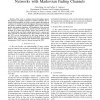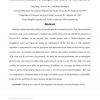165 search results - page 6 / 33 » Impact of multipath fading in wireless ad hoc networks |
WIOPT
2011
IEEE
12 years 11 months ago
2011
IEEE
—Most work on wireless network throughput ignore the temporal correlation inherent to wireless channels, due to trouble with tractability. In order to better capture the temporal...
PE
2006
Springer
13 years 7 months ago
2006
Springer
Existing wireless networks usually provide multiple data transmission rates. This paper presents a simulation study on the performance of multiple-rate mobile ad hoc networks (MAN...
WONS
2005
IEEE
14 years 1 months ago
2005
IEEE
In this paper we describe AntHocNet, an algorithm for routing in mobile ad hoc networks based on ideas from the Nature-inspired Ant Colony Optimization framework. The algorithm co...
INFOCOM
2003
IEEE
14 years 27 days ago
2003
IEEE
- A mobile ad hoc network is an autonomous system of infrastructureless, multihop wireless mobile nodes. Reactive routing protocols perform well in such an environment due to their...
VTC
2010
IEEE
13 years 6 months ago
2010
IEEE
— Systematic Luby Transform (SLT) codes constitute rateless codes, which are capable of adaptively adjusting their code rate depending on the channel quality without any explicit...


